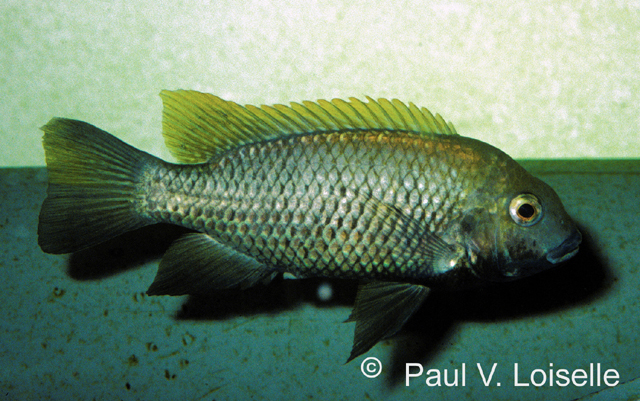| Cichlidae (Cichlids), subfamily: Pseudocrenilabrinae |
| 15 cm TL (male/unsexed) |
|
benthopelagic; freshwater |
| Africa: Lake Barombi-ba-kotta and Lake Mboandong, Cameroon (Ref. 52307, 81260). |
|
Dorsal spines (total): 14-16; Dorsal soft rays (total): 10-13; Anal spines: 3-3; Anal soft rays: 8-9. Diagnosis: dorsal fin with 14-16 spines and 10-13 soft rays; anal fin with 3 spines and 8-9 soft rays; 28-30 scales in lateral line; 8-10 gill rakers on lower limb of first arch (Ref. 81260).
Description: body ovoid and moderately deep; frontal profile straight to slightly rounded (Ref. 52307). Head length 33.7-37.0% SL; lower pharyngeal jaw with curved anterior teeth and tricuspid posterior teeth; ventral keel shorter than dentigerous plate; 3-4 tooth rows in oral jaws, outer row teeth bicuspid (Ref. 81260). Eyes relatively large (Ref. 52307).
Coloration: base body color brown (Ref. 81260) to coppery (Ref. 52307). When breeding (Ref. 52307), males with lower jaw, chest and belly dark brown or black, females with this region whitish; 4-5 vertical bars on flanks; soft dorsal with black "tilapia spot" and sometimes also with clear round maculae; caudal fin often with clear round maculae in upper lobe (Ref. 81260). Anal fin dark to black; pelvics black (Ref. 52307, 81260). Pectoral fins transparent (Ref. 81260). |
| Diet primarily consists of plants and small particles like detritus and aufwuchs; pair-bonding; prefers to spawn in obscured places, like crevices in sunken wood; both parents diligently guard eggs and fry (Ref. 52307). Substrate brooder (Ref. 81260). |
|
Endangered (EN); Date assessed: 16 February 2009 (B1ab(iii)+2ab(iii)) Ref. (130435)
|
| harmless |
Source and more info: www.fishbase.org. For personal, classroom, and other internal use only. Not for publication.

